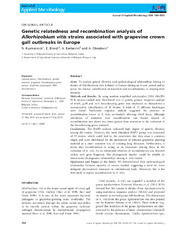Приказ основних података о документу
Genetic relatedness and recombination analysis of Allorhizobium vitis strains associated with grapevine crown gall outbreaks in Europe
| dc.creator | Kuzmanović, Nemanja | |
| dc.creator | Biondi, E. | |
| dc.creator | Bertaccini, Assunta | |
| dc.creator | Obradović, Aleksa | |
| dc.date.accessioned | 2020-12-17T21:14:22Z | |
| dc.date.available | 2020-12-17T21:14:22Z | |
| dc.date.issued | 2015 | |
| dc.identifier.issn | 1364-5072 | |
| dc.identifier.uri | http://aspace.agrif.bg.ac.rs/handle/123456789/3707 | |
| dc.description.abstract | AimsTo analyse genetic diversity and epidemiological relationships among 54 strains of Allorhizobium vitis isolated in Europe during an 8-year period and to assess the relative contribution of mutation and recombination in shaping their diversity. Methods and ResultsBy using random amplified polymorphic DNA (RAPD) PCR, strains studied were distributed into 12 genetic groups. Sequence analysis of dnaK, gyrB and recA housekeeping genes was employed to characterize a representative subcollection of 28 strains. A total of 15 different haplotypes were found. Nucleotide sequence analysis suggested the presence of recombination events in A.vitis, particularly affecting dnaK locus. Although prevalence of mutation over recombination was found, impact of recombination was about two times greater than mutation in the evolution of the housekeeping genes analysed. ConclusionsThe RAPD analysis indicated high degree of genetic diversity among the strains. However, the most abundant RAPD group was composed of 35 strains, which could lead to the conclusion that they share a common origin and were distributed by the movement of infected grapevine planting material as a most common way of crossing long distances. Furthermore, it seems that recombination is acting as an important driving force in the evolution of A.vitis. As no substantial evidence of recombination was detected within recA gene fragment, this phylogenetic marker could be reliable to characterize phylogenetic relationships among A.vitis strains. Significance and Impact of the StudyWe demonstrated clear epidemiological relationship between majority of strains studied, suggesting a need for more stringent phytosanitary measures in international trade. Moreover, this is the first study to report recombination in A.vitis. | en |
| dc.publisher | Wiley, Hoboken | |
| dc.relation | info:eu-repo/grantAgreement/MESTD/Integrated and Interdisciplinary Research (IIR or III)/46008/RS// | |
| dc.relation | info:eu-repo/grantAgreement/EC/FP7/316004/EU// | |
| dc.relation | JoinEU-SEE II scholarship (doctorate exchange) from Erasmus Mundus | |
| dc.rights | openAccess | |
| dc.source | Journal of Applied Microbiology | |
| dc.subject | Agrobacterium | en |
| dc.subject | Allorhizobium | en |
| dc.subject | genetic diversity | en |
| dc.subject | grapevine | en |
| dc.subject | housekeeping genes | en |
| dc.subject | random amplified polymorphic DNA | en |
| dc.subject | recombination | en |
| dc.title | Genetic relatedness and recombination analysis of Allorhizobium vitis strains associated with grapevine crown gall outbreaks in Europe | en |
| dc.type | article | |
| dc.rights.license | ARR | |
| dc.citation.epage | 796 | |
| dc.citation.issue | 3 | |
| dc.citation.other | 119(3): 786-796 | |
| dc.citation.rank | M22 | |
| dc.citation.spage | 786 | |
| dc.citation.volume | 119 | |
| dc.identifier.doi | 10.1111/jam.12858 | |
| dc.identifier.fulltext | http://aspace.agrif.bg.ac.rs/bitstream/id/23695/bitstream_23695.pdf | |
| dc.identifier.scopus | 2-s2.0-84939563586 | |
| dc.identifier.pmid | 26032990 | |
| dc.identifier.wos | 000360231000017 | |
| dc.type.version | publishedVersion |


